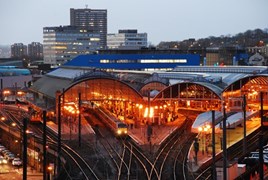 Read the peer review for this feature.
Read the peer review for this feature.
Download the graphs for this feature.
The number of political organisations shaping and influencing aspects of the railway is increasing. Alongside the Department for Transport, Transport for London, Transport Scotland and the National Assembly for Wales comes Rail North, a new organisation representing 29 local authorities.
West Midlands Rail will follow. Early lobbying is starting for a group to represent the South East outside London. And the South West is a potential candidate in the future. Each one believes its own geographical area deserves special treatment, extra funding and stronger local powers.
Do these bodies make life easier for the railway? Do they make it harder? Or do they merely make it more bureaucratic, adding layers of consultation and more politicians to please or appease?
Will fragmented political influence complicate the contest for limited funds and diminish control by a strategic-thinking national Government that can oversee competing geographical regions intent on boosting their own local agenda at the expense of the greater good? The system in well-funded Scotland is firmly established, while Transport for London wields enormous power in the capital - for more than one person in ten in the UK it is the most significant transport decision-maker.
“Local control has improved London Overground and Merseyrail by any measure you choose,” contends Stephen Joseph, chief executive of the Campaign for Better Transport.
“It has shown that local people take more care with the assets than civil servants in central Government are capable of doing. The benefits are clear and unambiguous.”
But what of the newcomers and the wannabes? The South East argues that it has lost out on rail funding, and deserves more. The home of HS1, Crossrail and Thameslink believes it has a compelling case. Meanwhile the North, still running unloved Pacers and comparatively under-financed for years, finds such claims risible.
In June, Secretary of State for Transport Patrick McLoughlin confirmed £13 billion of government transport infrastructure spending over the next five years to secure improvements in the North. The money includes pressing ahead with HS2.
McLoughlin said he would “progress plans” to “build on the concept” of HS3 for high-speed services linking the main Northern cities, reducing travel times and increasing service frequencies. Major road improvements are also included in the spending, including “looking at” building a road tunnel under the Peak District.
Rail North
Rail North represents an area of just ten million people, but a quarter of the national economy. That is much larger than Scotland, Wales and Northern Ireland combined. It is an economy greater than the individual countries of Denmark, Norway or Sweden. Yet it still relies on Pacer rail buses.
The Government says it wants to rebalance the national economy away from the congested South East, and away from a reliance on financial services. To achieve that, the North’s economy would need to grow at a rate faster than the country as a whole.
This new organisation represents 29 local transport authorities. Chaired by Sir Richard Leese, the leader of Manchester City Council, Rail North will be at the heart of a decentralised, devolved railway structure. On March 20, McLoughlin signed a Partnership Agreement for the management of the new Northern and TransPennine Express franchises, which start on April 1 2016. Rail North had already worked with DfT to develop the new franchise specifications.
The agreement includes mechanisms to enable the individual transport authorities to make decisions on changes to their own local rail services, and to make investments in these franchises. It also enables further devolution to take place during the life of the franchises, as the wider nature of political and economic devolution remains far from settled.
Train operators are currently finalising their pitches for the franchises. A preferred bidder will be announced at the end of this year.
Rail North’s strategy differs little from the national perspective in terms of its key messages - improved connectivity and a more coherent and user-friendly network with increased capacity, while ensuring that running costs per passenger fall. It covers 682 stations - just over one in four of the UK’s total.
Rail North is not to be confused with Transport for the North, although many of its members are the same. The latter is currently governed by an interim partnership board of the Department for Transport, Greater Manchester, Liverpool, Leeds, Sheffield, the North East and the Humber, together with Local Enterprise Partnerships, Network Rail, Highways England and HS2 Ltd. If that sounds large and lumbering, it does not even have a leader yet - an independent chairman is promised by the autumn, to spearhead Northern transport policy as a whole.











